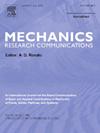极性线弹性悬臂梁的弯曲问题
IF 2.3
4区 工程技术
Q3 MECHANICS
引用次数: 0
摘要
本文旨在发起一项关于悬臂杆的线性弹性弯曲响应的研究,该悬臂杆具有极性材料行为的特征,同时也可能受到由于纤维存在而产生的各向异性特征的影响。现有的相应各向同性悬臂梁弯曲问题的精确弹性解目前局限在非极性线性弹性的范围内,并且只涉及问题的应力分析部分。该问题的完全解决仍然需要确定相应的位移场,这取决于杆截面的形状,也是解决所考虑的极性材料版本的问题所需要的。因此,本研究的本部分首先扩展了现有的非极性弹性解,包括代表材料正交异性类别的材料对称性,并通过确定具有圆形截面的正交异性悬臂梁的相应位移场来完成它。在材料各向同性的特殊情况下,通过(i)提供相应的位移场,(ii)研究相应的各向同性极性材料悬臂梁的弯曲响应,实现完成相应的非极性弹性解。然而,在极性横向各向同性的情况下也取得了实质性的类似进展,其中弯曲悬臂杆的极性材料响应是预期的,因为一组嵌入的纤维具有弯曲刚度。本文章由计算机程序翻译,如有差异,请以英文原文为准。
On the bending problem of a polar linearly elastic cantilever
This communication aims to initiate an investigation regarding the linearly elastic bending response of a cantilevered bar that exhibits features of polar material behaviour, while it may also be influenced by anisotropy features that are due to fibre presence. The existing exact elasticity solution of the bending problem of a corresponding isotropic cantilever is currently confined within the bounds of the non-polar linear elasticity, and refers only to the stress analysis part of the problem. Complete solution of that problem still requires determination of the corresponding displacement field, which depends on the shape of the bar cross-section and is also needed for the solution of the considered polar material version of the problem. Accordingly, the present part of this investigation initially extends the existing non-polar elasticity solution by including material symmetries that represent the class of material orthotropy, and completes it by determining the corresponding displacement field for an orthotropic cantilever with circular cross-section. In the special case of material isotropy, it then achieves to complete the corresponding non-polar elasticity solution, by (i) providing the relevant displacement field, and (ii) studying the bending response of the corresponding isotropic polar material cantilever. Nevertheless, substantial similar progress is also made in a case of polar transverse isotropy, where polar material response of a bent cantilever bar is anticipated due to a family of embedded fibres that possess bending stiffness.
求助全文
通过发布文献求助,成功后即可免费获取论文全文。
去求助
来源期刊
CiteScore
4.10
自引率
4.20%
发文量
114
审稿时长
9 months
期刊介绍:
Mechanics Research Communications publishes, as rapidly as possible, peer-reviewed manuscripts of high standards but restricted length. It aims to provide:
• a fast means of communication
• an exchange of ideas among workers in mechanics
• an effective method of bringing new results quickly to the public
• an informal vehicle for the discussion
• of ideas that may still be in the formative stages
The field of Mechanics will be understood to encompass the behavior of continua, fluids, solids, particles and their mixtures. Submissions must contain a strong, novel contribution to the field of mechanics, and ideally should be focused on current issues in the field involving theoretical, experimental and/or applied research, preferably within the broad expertise encompassed by the Board of Associate Editors. Deviations from these areas should be discussed in advance with the Editor-in-Chief.

 求助内容:
求助内容: 应助结果提醒方式:
应助结果提醒方式:


